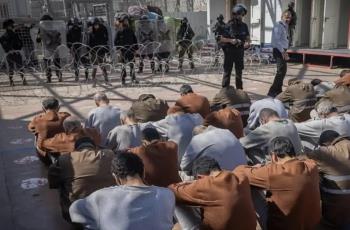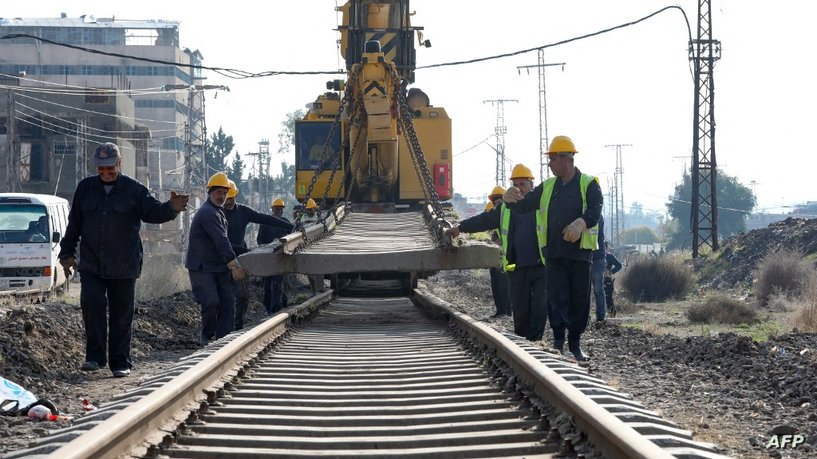Alwaght- In addition to setting a new record of pilgrims, the 2023 Arbaeen presented a very beneficial promise of expansion of trade and facilitation of travel of Iranian and Iraqi citizens and it was the beginning of the last phase of rail link between Iran’s Shalamcheh and Iraq’s Basra by high-ranking officials from both countries.
Iraqi Prime Minister Mohammed Shia al-Sudani and Iran’s Vice President Mohammed Mokhber last week set the foundation for the rail route of the Shalamcheh Border Crossing for this old project to be concluded as fast as possible.
According to Iranian officials, this is part of a strategic plan of the two countries and links rail networks of the two neighbours to each other and is a supplement to the international transportation routes. During the groundbreaking ceremony, Mokhber said: “This important route will be completed with the cooperation of the two countries in the next two years within the framework of the policy of strengthening relations with the neighbors, and we hope that it will be a source of good and blessings for Iran and Iraq as well as the countries of the region.”
Shalamcheh-Basra railway is 32 kilometers long and connects the city of Basra in southeastern Iraq to Khorramshahr in Khuzestan Province in southwestern Iran. According to the agreements, 16 kilometers of this project will be built in Shalamcheh by Iran Railways Company and the other 16 kilometers will be built by the Iraqi government.
The project was launched decades ago, but the Iraqi side neglected it for a variety of reasons. In 2011, Iran completed the 17-kilometer Khorramshahr-Shalmeche railway, which was supposed to connect to Basra, but the project was suspended for over a decade. This railway has had many opponents inside Iraq and abroad, and according to reports, in recent years, the US pressured Iraqi government to avoid its conclusion, but the foreign pressures could not prevent the realization of the dream of the two countries, and after several meetings of senior officials of Iran and Iraq, the completion of this rail route was again put on agenda.
The economic benefits of Iran from the railway
The railway, which is planned to be connected to international rail network bears abundant economic benefits for Iran. Here are some of them.
First, the most important function of rail routes is expansion of trade between the countries. Iran is no exception and can take benefit from Shalamcheh-Basra railway to boost its trade with Iraq for cheaper imports and exports and in shortest time. Iraq is Iran’s second largest trade partner and with completion of this rail transit corridor, their trade ties will see further prosperity and they will realize the target of $20 billion trade volume even sooner than planned. Iran’s exports volume to Iraq is currently $12 to $130 billion, $9 billion of which are private sector products and $3 to $4 billion are energy and power exports. Once this project is concluded, the Iranian goods will reach Iraq even faster.
Second, the transfer of passengers is one of the main aims of the Shalamcheh-Basra railway, and since every year millions travel to Iraqi holy shrines, this railway can play a major role in transfer of pilgrims, especially at the time of Arbaeen. This will help improve the cultural exchanges between the two nations. Since the railway transportation is safer than road and air transportation, this rail road can enhance the safety and security of the Arbaeen pilgrims and help ease the human traffic at the border crossings.
Miad Salehi, the head of the Islamic Republic of Iran Railways, said that this railway can carry 8 to 10 million tons of goods and around 12 millions of passengers annually.
Third, access to the Mediterranean Sea is a strategic goal for Iran, and Tehran plans to achieve it through the Iraqi railways and then by connecting to the Syrian railways, and once this process is completed, exporting goods to Syria, Lebanon, and Europe will be done in a short time and at a low cost. For more than a decade, the crisis in Syria posed a big challenge for transportation of Iranian goods to this country, either by air, sea or land, but now with the end of the crisis and Damascus’ control over the security situation, the conditions for the expansion of bilateral trade and even the export of Iranian goods from Syria to other countries in the region have been provided. Shalamcheh-Basra rail line will help greatly in this process. Since Syria is in post-war reconstruction period, Iran, as one of its staunch allies, can speed up the reconstruction process by transferring construction materials and technical assistance through railways.
Fourth, with Iran being a global transit confluence, Tehran can be linked to the Persian Gulf, especially Saudi Arabia and Kuwait, railway network through Shalamcheh-Basra rail road and bolster its trade with the Persian Gulf monarchies through this transit route.
Fifth, with Iran being under strict Western sanctions over the past four decades, this railway can help it effectively circumvent the Western restrictions and pressures.
Sixth, this railway will improve Iran’s geographical position in China’s Road and Belt Initiative (RBI), and Tehran will be the main actor in West Asia and turn into a regional trade hub.
Iraqi benefits from international corridor
This railway is as beneficial for Iraq as it is for Iran. First of all, Iraq, which in recent years has been grappling with economic crisis due to political and security instability, can enhance its economic conditions through trade boost with Iran.
Second, this railway will contribute to development of religious tourism in Iraq. According to the official statistics this year, 4 million people from Iran participated in the Arbaeen marches, and thousands more people visit the holy shrines in Iraq over the year, and therefore, with the development of rail infrastructure, millions of passengers can enjoy convenient travel. In this regard, Iraqi PM said in his speech that the connection of the railway to Iran for the transfer of passengers will activate Iraqi transport sector. Al-Sudani also held that the Iraqi minister of transportation discussed with Riyadh officials railway connection to Saudi Arabia for the transportation of Hajj pilgrims. Therefore, with the completion of the Shalamcheh-Basra railway and its connection to the Persian Gulf railway network, Iraqi tourism will enjoy prosperity.
Third, this project will enable Iraq to easily access to Iran’s vast railway network to the eastern Iranian borders. This connection opens the door for Iraqi access to Afghanistan, Pakistan, Caucasus, Central Asia, and Far East. Iraq is mainly engaged in trade with these regions through air and sea routes, which are costly. But railways will help it do business with them cheaper.
Fourth, this project turns Iraq into a transit route for trade between the Arab countries of the Persian Gulf region and the Central Asian republics and Russia. Iran and Russia have recently signed an agreement on the construction of the Rasht-Astara railway to complete the North-South Corridor, and the Shalamcheh-Basra railway will also be connected to this international corridor.
Regional benefits
The joint infrastructural projects cannot just be considered from economic aspect and geopolitical outcomes also need to be taken into consideration. There is no doubt that Iran-Iraq rail connection will enhance the connection of West Asian countries and increase the need for powers to work with this region that is strategically part of the significant Heartland region.
On the other hand, the new project will facilitate transferring passengers from Central Asian countries and Azerbaijan to Iraq and from there to other countries, especially Saudi Arabia, during Hajj and Umrah seasons.
In recent months, Oman and Saudi Arabia have announced their readiness to develop railway infrastructure for interaction with Central Asia. Shalamcheh-Basra railway will be at the center of these transit routes and strengthen the trade between the Central Asian republics and the Persian Gulf. Last year, Central Asian leaders announced their readiness to use Iran’s transit corridors, and the conditions are ready for the development of trade among neighbors, and construction of Iran-Iraq railway as a missing linking ring can prompt profitable regional trade.
Furthermore, the wider railroads expand among regional countries, the lesser regional tensions will be because of shared interest, and this bolsters regional peace and security.
Though recently Iraq and Turkey struck a deal for rail connection to Basra and from there to the Persian Gulf, this railway is not in conflict with Shalamcheh-Basra railway, and by the way once they are connected, they can grant the region a bigger opportunity for prosperity and strengthen the political convergence recently established between Iran and its neighbors, something decreasing the foreign interference meant to damage relations among countries.
Linking Iran’s rail corridors to international transit corridors has proven that the US efforts to tighten the noose on Iran have been a failure story, and the prospects of trade cooperation show that Tehran does not have a long way to transformation into a regional trade hub.



























